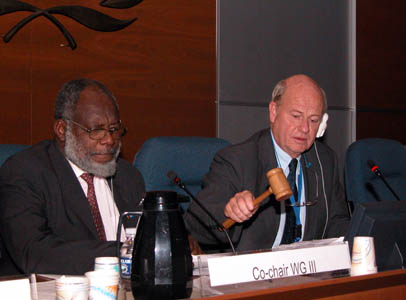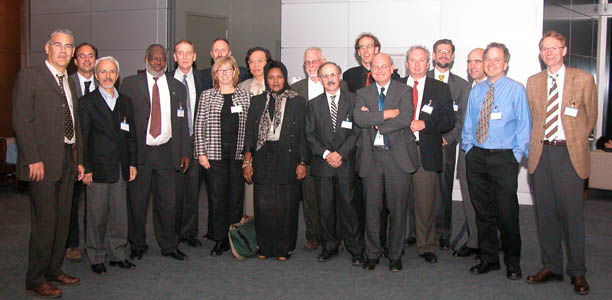|
| Right
photo L-R: Lead
Author David Keith (center) in discussion with Olav Hohmeyer
(Germany), Klaus Radunsky (Austria) and José Romero
(Switzerland). |
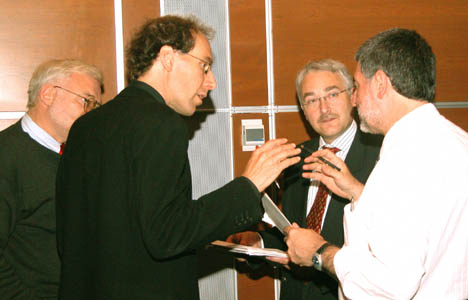 |
|
|
|
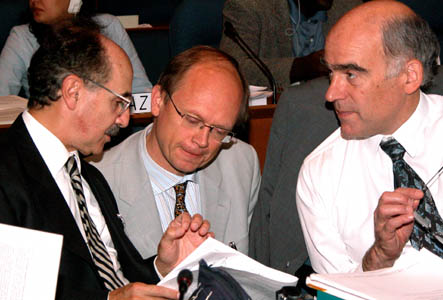
|
Highlights
for Saturday, 24 September 2005
On Saturday, delegates continued line-by-line
deliberations over the draft SPM in plenary. In the
morning, delegates finished consideration of a section
of the SPM concerned with the costs of CCS and its
economic potential. In the afternoon, evening and late
into the night, delegates considered sections on inter
alia: local health, safety and environmental risks
of CCS; global risks of CCS; legal issues for
implementing carbon dioxide storage; implications of CCS
for emission inventories and accounting; and the public
perception of CCS.
Left photo L-R: Lead
Authors Ed Rubin and Paul Freund in
consultation with
J.P. van Ypersele (Belgium)
(center) |
|
|
|
|
CONSIDERATION
OF THE DRAFT SUMMARY FOR POLICYMAKERS
|
|
What
are the costs of CCS and what is its economic potential?
After
the
US
expressed concern about text being policy prescriptive, delegates
agreed to reword a sentence to state that “energy and economic
models indicate that the major CCS system’s contribution to
climate change mitigation would come from deployment in the energy
sector.” Delegates then considered text on the minimum carbon
dioxide emission reduction prices for a major CCS contribution to
mitigation.
|
|
|

|
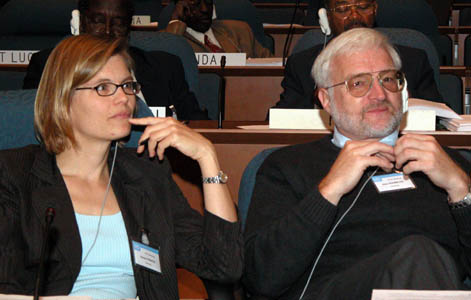
|
|
CHILE
and
NEW ZEALAND
expressed concern over the US$ 25 - 30 price quoted in the
draft SPM, given the
potential for the long lifetimes of some projects.
Above photo: David Wratt (New Zealand)
|
On text noting that worldwide storage capacity in
geological formations is likely to be at least 2,000 Gt CO2
of storage capacity, discussions centered on the figure of
2,000 Gt CO2.
DENMARK
and
GERMANY
suggested noting that the amount is an estimate.
Above photos L-R: Ursula Fuentes and Olav Hohmeyer
(Germany)
|
|
|
|
|
|
|
|
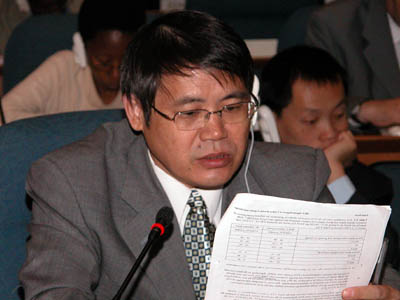
|
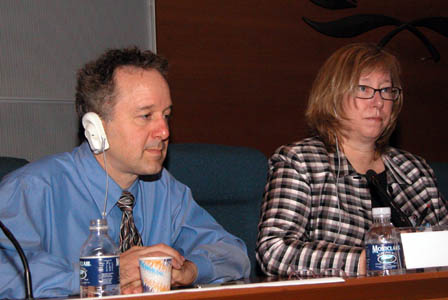
|
|
CHINA
expressed concern
that the text does not explain that
2,000 Gt CO2 relates to
technical, as opposed to economic, potential.
Above
photo L-R: Jiahua Pan (China)
|
Lead Author Sally Benson explained the origin of the
2,000 Gt CO2 figure.
Above
photo L-R: Lead Authors Ken Caldeira and Sally
Benson
|
|
|
|
|

|
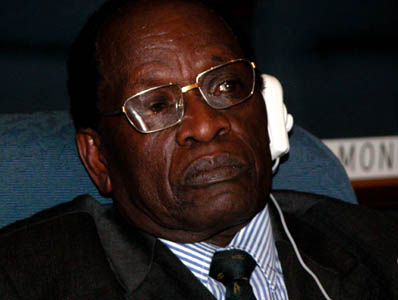
|
|
GERMANY
noted that ocean
storage potential cannot be compared to geological storage
potential given their very different retention times.
Above photo: Ursula Fuentes (Germany)
|
GERMANY
,
AUSTRIA
, and
KENYA
highlighted the relevance of a figure portraying
the contribution of CCS as part of a mitigation portfolio.
Above photo L-R: Richard Odingo (Kenya) |
|
|
|
|
|
|
What
are the local health, safety and environmental risks of CCS?
|
|
|
|
|
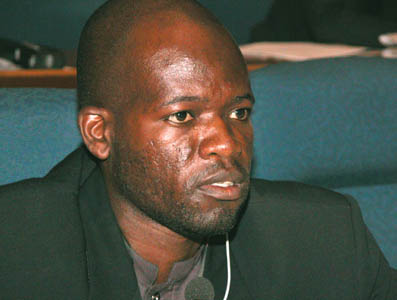
|
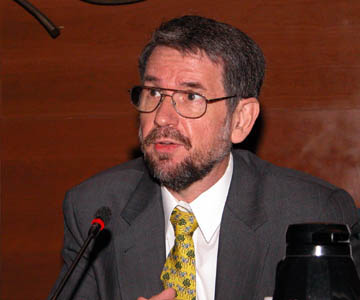
|
|
On
local risks associated with carbon dioxide pipeline transport,
ZAMBIA
sought clarification of a statement that the risks are possibly
lower than comparable hydrocarbon pipelines in operation.
Above photo: Lemmy Namayanga (Zambia)
|
Lead Author Richard Doctor explained that the statement
was based on 20 years of experience in the US. The text was accepted without amendment.
Above photo: Lead Author Richard Cook
|
|
|
|
|
|

|
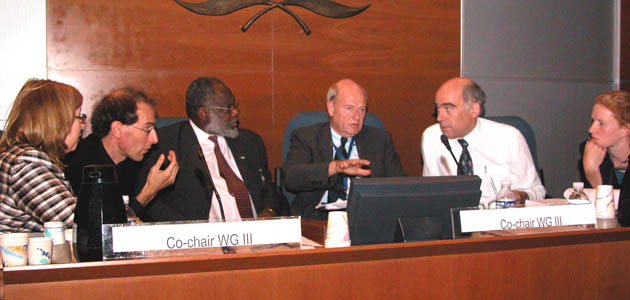 |

|
|
|
Above photos L-R: IPCC Chairman Rajendra Pachauri (India)
with Renate Christ, Secretary IPCC; Co-Chairs Davidson
and
Metz in consultation with Lead Authors Sally Benson,
David Keith and Paul Freund, with Heleen de
Connick (IPCC)observing; Lead Authors Makoto Akai and
Ken Caldeira.
|
|
|
|
|

|

|
|
On
a paragraph addressing the effects on ecosystems of direct
carbon dioxide injection into the ocean, discussion focused on
whether injection “would” or “could” cause mortality of
ocean organisms. JAPAN
sought to include text specifying that mortality only occurs
near injection points.
Above photo L-R: Masahiro Nishio and Toshiyuki
Sakamoto (Japan)
|
CHILE,
supported by
MALAYSIA
and CHINA , said ocean effects could not be inferred from the results of
existing studies in confined environments.
Above photo: Samsudin Musa (Malaysia)
|
|
|
|
|
|
Will
physical leakage of stored CO2 compromise CCS as a climate change
mitigation option?”
|
|
|

|
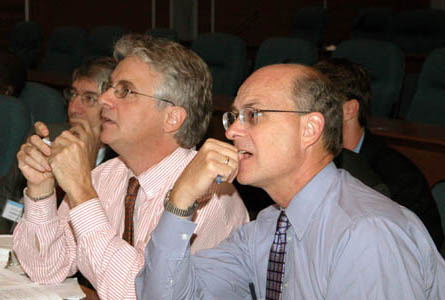
|
|
After
revising the section title to better reflect the issues
addressed, delegates reorganized the text in this section.
FRANCE
, with support from others, stressed the need to highlight that
leakage from ocean storage could offset some of the benefits of
CCS.
Above photo: Jacques Varet (France)
|
The
US, with support from JAPAN, CANADA and others, proposed
separating wording on geological and ocean storage because
retention issues for each type of storage is different, and to
include mineral carbonation as a separate heading. Delegates
approved text that divides the text based on this proposal.
Above photo L-R: Trigg Talley and Michael Artts
(US)
|
|
|
|
|
What
are the legal and regulatory issues for implementing CO2 storage?
|
|
Discussion for geological storage
focused on the type of sources, the distance from sources to storage locations, and the location of sources.
|
|
|
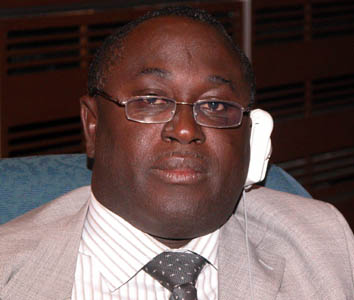
|

|
|
GHANA
, supported by
SWITZERLAND
,
CANADA
and
NORWAY
, noted that the list of existing regulations that could be
directly applicable to geological storage was limited.
Above photo: William K. Agyemang-Bonsu (Ghana)
|
Delegates agreed to add “inter alia” before the list, and to add pollution controls to the
list as proposed by
NORWAY
.
Above photo L-R: Øyvind Christopherson and Torgim Asphjell
(Norway)
|
|
|
|
|
|
Above photo L-R: Coordinating Lead
Authors Carlos Abanades, Keywan Riahi, Mohammed Soltanieh, Ogulade
Davidson, Peter Cook, Marco Mazzotti, Sally Benson, Makoto Akai,
Balgis Osman-Elasha, Howard Herzog, Ed Rubin, David Keith, Bert Metz,
John Gale, Richard Doctor, Paul Freund, Ken Caldeira, and Wolfgang
Heidug. Missing in action Kelly Thambimuthu, Andrew Palmer, Koen
Smekens, Jim Dooley, Riitta Pipatti
|
|
|
|

